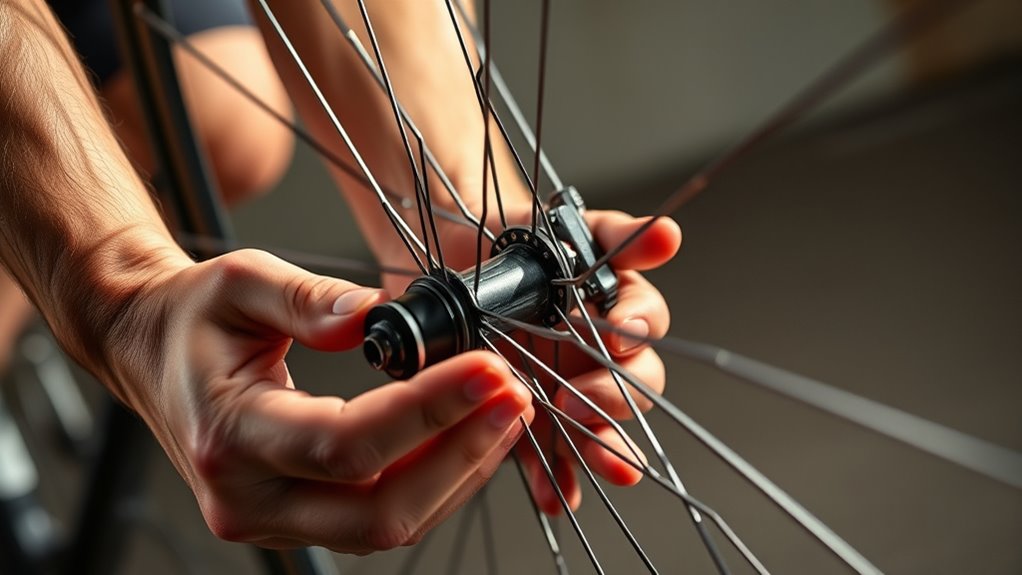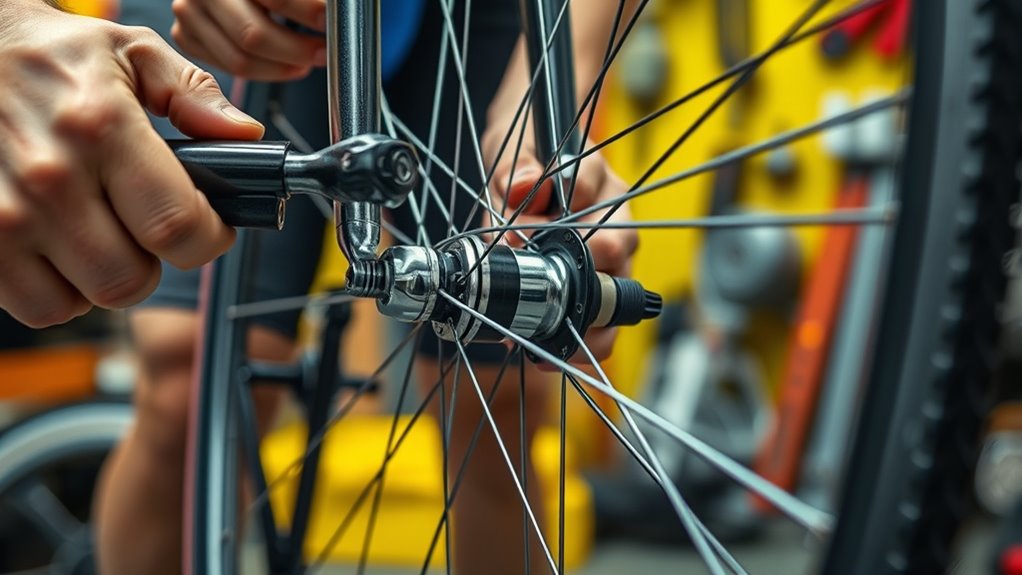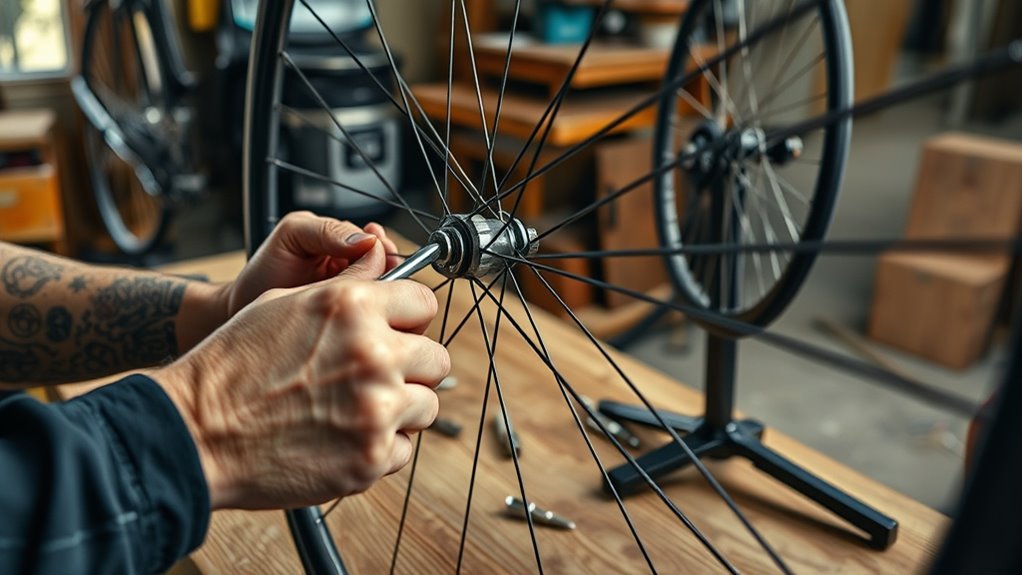To true a wheel at home, start by properly setting up in a clean, well-lit workspace with basic tools like a spoke wrench and a truing stand or makeshift setup. Spin the wheel to identify wobbles, then adjust spoke tension on the opposite side of the wobble in small, gradual turns. Focus on both side-to-side and up-down deviations, and recheck regularly. If you keep these tips in mind, you’ll discover key tricks that make the process easier.
Key Takeaways
- Remove the wheel and set up a clean, well-lit workspace with essential tools like a truing stand or makeshift jig.
- Spin the wheel to identify wobble, then inspect spokes, rim, and hub for damage or misalignment.
- Adjust spoke tension gradually—tighten on the side opposite the wobble and loosen the opposite side.
- Continuously recheck trueness after each adjustment, focusing on both lateral and radial deviations.
- Test ride to verify wheel stability, brake performance, and make final fine-tuning for a smooth, true wheel.
Understanding Wheel Wobble and Its Causes

Wheel wobble often indicates that something is out of alignment or has a defect. One common cause is rim damage, which can throw off the wheel’s balance and create wobble. When the rim is bent or cracked, it no longer spins true, making your ride uneven. Another factor is spoke tension; uneven tension can cause the rim to shift or warp over time. Loose spokes may allow parts of the wheel to shift, while overly tight spokes can distort the rim’s shape. Regularly inspecting your wheel for signs of rim damage and maintaining even spoke tension helps prevent wobble. Additionally, advancements in machine learning algorithms are being utilized to develop more precise tools for detecting wheel imbalances and defects early, helping to address issues before they lead to safety concerns. Recognizing these issues early allows you to address them before they worsen, ensuring a smoother, safer ride.
Essential Tools and Setup for Truing a Wheel at Home

To true a wheel at home, you’ll need some basic tools like a spoke wrench and a truing stand. Setting up a clean, well-lit workspace guarantees accuracy and safety during the process. With the right tools and setup, you’ll make precise adjustments and get your wheel spinning smoothly again. Understanding symptoms of imbalance can help identify when a wheel needs truing, ensuring safe and effective repairs.
Basic Truing Tools
Having the right set of tools is essential for truing a wheel accurately at home. You’ll need a spoke wrench compatible with your spoke nipples to adjust spoke tension precisely. A truing stand is ideal, but a good work surface can suffice if used carefully. A spoke tension meter helps you gauge uniform tension across spokes, preventing weak spots. Don’t forget a rim gauge or caliper for rim inspection, ensuring the rim isn’t bent or cracked. A marker or chalk is useful for marking out deformations or areas needing attention. With these tools, you can identify uneven spoke tension and rim irregularities, making precise adjustments easier. Properly equipped, you’ll be able to true your wheel efficiently, ensuring a smooth ride and prolonging wheel life. Additionally, understanding how to properly assess rim conditions can help prevent future issues and maintain optimal performance.
Proper Workspace Setup
Setting up your workspace properly guarantees you can work efficiently and safely when truing a wheel. A well-organized area ensures tools are accessible and your focus stays sharp. Good workshop lighting is vital, so position bright, focused lights to eliminate shadows and see wheel imperfections clearly. Keep your tools and parts organized with storage solutions that prevent clutter and damage. Consider these essentials:
- Adequate lighting to illuminate the truing stand and wheel
- A sturdy workbench with ample space for tools and wheel handling
- Storage containers or shelves for tools, spare spokes, and accessories
- A designated, clutter-free area to maintain focus and safety
- Regular maintenance and cleaning of your workspace and tools ensure smooth operation for better precision and safety.
A clean, well-lit workspace with organized storage helps you work precisely and confidently.
Step-by-Step Guide to Identifying the Problem Areas

Identifying the problem areas in a wheel is the essential first step before you can true it effectively. Start by spinning the wheel and observing where it wobbles or rubs against the brake pads. Check the hub bearings for play—loose or rough bearings can cause wobbling and uneven spoke tension. Feel for any side-to-side movement or roughness when spinning the wheel. Inspect the spokes for broken or bent spokes, which can create localized wobbles. Use a visual aid or a truing stand if available to pinpoint uneven areas. Remember, inconsistent spoke tension often causes the wheel’s deviation. Proper bearing maintenance can prevent many common issues and improve wheel stability. Carefully note where the wheel deviates and whether the issue seems to stem from hub bearings or spoke tension irregularities. This will guide your truing process.
Techniques for Correcting Side-to-Side and Radial Trueness

To correct side-to-side and radial deviations, you’ll need to use precise spoke adjustments with your truing tools. Start by identifying the areas where rim wobble or misalignment occurs. Then, follow these steps:
- Adjust spoke tension on the side opposite the wobble to pull the rim into alignment.
- Tighten or loosen spokes gradually, ensuring even tension to maintain spoke tension balance.
- Focus on small, incremental changes to avoid overcorrecting.
- Constantly check rim alignment with your truing stand, paying attention to both lateral and radial deviations.
- Remember that consistent tensioning and understanding the wheel’s structure are essential for achieving a true wheel.
Maintaining proper spoke tension is key to achieving true side-to-side and radial trueness, preventing rim wobble and ensuring rim alignment. This method delivers a stable, smooth ride.
Tips for Fine-Tuning and Ensuring a Smooth Ride

Start by checking your wheel’s trueness to confirm any remaining wobble. Carefully adjust the spokes, making small, incremental turns to bring everything into alignment. Once adjustments are complete, take a test ride to ensure your wheel spins smoothly and your ride feels balanced. Remember to verify that your wheel is free of any spoilage signs such as off-smell or discoloration to prevent potential issues while riding.
Check Wheel Trueness
Ever wonder if your wheel is perfectly straight? Checking wheel trueness is essential for a smooth ride. First, spin the wheel and observe if it wobbles side to side or up and down. Next, focus on these key areas:
- Ensure spoke tension is even, as uneven tension can cause wobbling.
- Look for signs of wheel dishing, where the rim is off-center relative to the hub.
- Use a truing stand or a fixed point like brake pads or a ruler to measure lateral and radial run-out.
- Tighten or loosen spokes gradually in small increments in accordance with proper maintenance techniques to correct any deviations, without affecting wheel dishing unnecessarily.
Adjust Spokes Carefully
Once you’ve identified any wobbling or irregularities in your wheel, carefully adjusting the spokes is key to restoring true alignment. Start by checking the spoke tension—tighten spokes on the side pulling the wheel out of true, and loosen those on the opposite side. Be precise with each turn, making small adjustments to avoid overcorrecting. Pay close attention to wheel dishing; uneven tension can cause the rim to shift side to side, so ensure the wheel remains centered. Use a dishing tool if needed to verify alignment. Remember, even tension across spokes helps maintain a smooth ride and prolongs wheel durability. Additionally, understanding the effectiveness of eye patches can guide you in choosing products that improve skin hydration and appearance, which can be especially beneficial after long rides. Take your time, making incremental changes, and regularly recheck the wheel’s true position as you go.
Test Ride Properly
How do you know if your wheel is truly straight and functioning smoothly? The best way is to take a careful test ride. Pay close attention to your bike handling and how it responds. During the ride, focus on these key points:
- Feel for any wobbling or vibrations that indicate unevenness.
- Check if the bike tracks straight without steering correction.
- Notice if the brakes engage evenly and smoothly.
- Observe how the wheel responds over bumps or rough surfaces.
- Ensure your wheel is properly trued to avoid further issues during rides.
A proper test ride helps you identify subtle issues that might affect your ride quality. If anything feels off, recheck your truing and spokes. Fine-tuning your wheel guarantees a smoother, safer ride every time.
Common Mistakes to Avoid and Maintenance Tips

To keep your wheel true and avoid unnecessary setbacks, it’s essential to recognize common mistakes and follow proper maintenance practices. One mistake is uneven spoke tension, which can cause wobbling and rim misalignment. Regularly check and adjust spoke tension to ensure a consistent distribution. Another mistake is neglecting rim alignment; a poorly aligned rim can lead to uneven wear and poor handling. Always inspect the rim for true and correct any deviations early. Avoid over-tightening spokes, as this can weaken the wheel and cause damage. Keep your hub bearings properly lubricated and free of dirt to prevent play and ensure smooth rotation. By paying attention to spoke tension and rim alignment, and performing routine checks, you’ll maintain a true wheel and enjoy safer, more efficient rides.
Frequently Asked Questions
How Often Should I Check My Wheel Trueness?
You should check your wheel trueness every 1 to 2 months, especially if you ride frequently or notice uneven tire pressure. Regular checks help you spot issues with spoke tension early, preventing wobbling or damage. After every ride, inspect for wobbles or loose spokes, and adjust spoke tension as needed. Keeping your wheel authentic ensures smoother rides, better tire pressure, and longer-lasting spokes and rims.
Can I True a Wheel Without Removing the Tire?
Yes, you can true a wheel without removing the tire, but it’s important to inspect the tire first for any damage or debris that could interfere. Check the rim for any damage or dents, as this affects truing. If the tire is in good condition and properly seated, you can use a spoke wrench to adjust the spokes and correct wobbles. Always prioritize rim integrity and tire safety during the process.
How Do I Fix a Warped Rim?
A warped rim feels like a bicycle gone rogue, but you can fix it. Start by checking spoke tension; loosen or tighten spokes opposite the deformation to straighten the rim. Focus on rim deformation, adjusting tension evenly to restore true alignment. Patience is key—small tweaks make a big difference. With steady hands and attention to detail, you’ll bring your wheel back to perfect roundness, ready for smooth rides once again.
What Signs Indicate a Wheel Needs Truing?
You’ll notice rim wobble when your wheel isn’t true, causing it to shake side to side or hop while riding. Uneven spoke tension can also be a sign, as some spokes may be loose or too tight, affecting wheel stability. If your bike feels unsteady, or if you see the rim deviating from the brake pads, it’s time to check for these signs and true your wheel.
Is Truing Necessary for All Types of Bikes and E-Bikes?
Think of your bike as a finely tuned orchestra; every part needs harmony. Truing isn’t necessary for all bikes and e-bikes, but it’s essential when your wheel wobbles or feels uneven. Proper bike maintenance includes wheel alignment, ensuring smooth rides and preventing premature wear. Regularly check your wheels—if they’re out of line, a quick truing keeps your bike singing in harmony, no matter the type.
Conclusion
Now that you know how to true a wheel at home, you hold the steering wheel of your ride’s future. With patience and practice, you can smooth out those wobbles like a skilled artist restoring a masterpiece. Remember, every turn and tweak brings your wheel closer to perfection—making your cycling experience as seamless as a gentle breeze. So, grab your tools and get ready to keep your bike rolling flawlessly, mile after mile.









